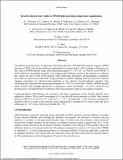InAsSb detectors for visible to MWIR high operating temperature applications
Author(s)
D'Souza, Arvind I.; Ionescu, A. C.; Salcido, M.; Robinson, E.; Dawson, L. C.; Okerlund, D. L.; de Lyon, T. J.; Rajavel, R. D.; Sharifi, H.; Yap, D.; Beliciu, M.L.; Mehta, S.; Dai, W.; Chen, Gang; Dhar, Nibir; Wijewarnasuriya, P.; ... Show more Show less
DownloadChen_InAsSb detectors.pdf (999.5Kb)
PUBLISHER_POLICY
Publisher Policy
Article is made available in accordance with the publisher's policy and may be subject to US copyright law. Please refer to the publisher's site for terms of use.
Terms of use
Metadata
Show full item recordAbstract
The Photon-Trap Structures for Quantum Advanced Detectors (PT-SQUAD) program requires MWIR detectors at 200 K. One of the ambitious requirements is to obtain high (> 80 %) quantum efficiency over the visible to MWIR spectral range while maintaining high D* (> 1.0 x 1011 cm √Hz/W) in the MWIR. A prime method to accomplish the goals is by reducing dark diffusion current in the detector via reducing the volume fill ratio (VFR) of the detector while optimizing absorption. Electromagnetic simulations show that an innovative architecture using pyramids as photon trapping structures provide a photon trapping mechanism by refractive-index-matching at the tapered air/semiconductor interface, thus minimizing the reflection and maximizing absorption to > 90 % over the entire visible to MWIR spectral range. InAsSb with bandgap appropriate to obtaining a cutoff wavelength ~ 4.3 μm is chosen as the absorber layer. An added benefit of reducing VFR using pyramids is that no AR-coating is required. Compound-barrier (CB) detector test structures with alloy composition of the InAsSb absorber layer adjusted to achieve 200 K cutoff wavelength of 4.3 μm (InAsSb lattice-matched to GaSb). Dark current density at 200 K is in the low 10-4 A/cm2 at Vd = -1.0 V. External QE ~ 0.65 has been measured for detectors with a Si carrier wafer attached. Since illumination is through the Si carrier wafer that has a reflectance of ~ 30 %, this results in an internal QE > 0.9.
Date issued
2011-05Department
Massachusetts Institute of Technology. Department of Mechanical EngineeringJournal
Proceedings of SPIE--the International Society for Optical Engineering
Publisher
SPIE--the International Society for Optical Engineering
Citation
D'Souza,A. I., A. C. Ionescu, M. Salcido, E. Robinson, L. C. Dawson, D. L. Okerlund, T. J. de Lyon, R. D. Rajavel, H. Sharifi, D. Yap, M. L. Beliciu, S. Mehta, W. Dai, G. Chen, N. Dhar and P. Wijewarnasuriya. "InAsSb detectors for visible to MWIR high-operating temperature applications", In Infrared Technology and Applications XXXVII, edited by Bjørn F. Andresen; Gabor F. Fulop; Paul R. Norton, Orlando, Florida, USA, April 25, 2011. 80122S. (SPIE Proceedings; vol. 8012). © 2011 SPIE.
Version: Final published version
Other identifiers
Proceedings of SPIE ; vol. 8012
ISBN
9780819485861
0819485861
ISSN
0277-786X